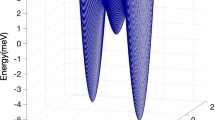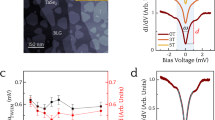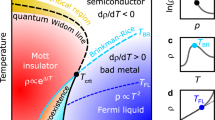Abstract
Metal-to-insulator transitions1 driven by strong electronic correlations occur frequently in condensed matter systems, and are associated with remarkable collective phenomena in solids, including superconductivity and magnetism. Tuning and control of the transition holds the promise of low-power, ultrafast electronics2, but the relative roles of doping, chemistry, elastic strain and other applied fields have made systematic understanding of such transitions difficult. Here we show that existing data3,4,5 on the tuning of metal-to-insulator transitions in perovskite transition-metal oxides through ionic size effects provides evidence of large systematic effects on the phase transition owing to dynamical fluctuations of the elastic strain, which have usually been neglected6. We illustrate this using a simple yet quantitative statistical mechanical calculation in a model that incorporates cooperative lattice distortions coupled to the electronic degrees of freedom. We reproduce the observed dependence of the transition temperature on the cation radius in the well studied manganite7 and nickelate8 materials. Because elastic couplings are generally strong, we anticipate that these conclusions will generalize to all metal-to-insulator transitions that couple to a change in lattice symmetry.
This is a preview of subscription content, access via your institution
Access options
Access Nature and 54 other Nature Portfolio journals
Get Nature+, our best-value online-access subscription
$29.99 / 30 days
cancel any time
Subscribe to this journal
Receive 51 print issues and online access
$199.00 per year
only $3.90 per issue
Buy this article
- Purchase on Springer Link
- Instant access to full article PDF
Prices may be subject to local taxes which are calculated during checkout




Similar content being viewed by others
Data availability
Requests for materials should be addressed to G.G.G.-V., and P.B.L.
References
Imada, M., Fujimori, A. & Tokura, Y. Metal-insulator transitions. Rev. Mod. Phys. 70, 1039 (1998).
Yang, Z., Ko, C. & Ramanathan, S. Oxide electronics utilizing ultrafast metal-insulator transitions. Annu. Rev. Mater. Res. 41, 337–367 (2011).
Torrance, J. B., Lacorre, P., Nazzal, A. I., Ansaldo, E. J. & Niedermayer, Ch. Systematic study of insulator-metal transitions in perovskites RNiO3 (R = Pr, Nd, Sm, Eu) due to closing of charge-transfer gap. Phys. Rev. B 45, 8209–8212 (1992).
Hwang, H. Y., Cheong, S.-W., Radaelli, P. G., Marezio, M. & Batlogg, B. Lattice effects on the magnetoresistance in doped LaMnO3. Phys. Rev. Lett. 75, 914–917 (1995).
Rodriguez-Martinez, L. M. & Attfield, J. P. Cation disorder and size effects in magnetoresistive manganese oxide perovskites. Phys. Rev. B 54, R15622(R) (1996).
Khomskii, D. I. Transition Metal Compounds (Cambridge University Press, 2014).
Tokura, Y. Critical features of colossal magnetoresistive manganites. Rep. Prog. Phys. 69, 797–851 (2006).
Catalano, S. et al. Rare-earth nickelates RNiO3: thin films and heterostructures. Rep. Prog. Phys. 81, 046501 (2018).
Katsufuji, T., Taguchi, Y. & Tokura, Y. Transport and magnetic properties of a Mott–Hubbard system whose bandwidth and band filling are both controllable: R1−xCaxTiO3+y/2. Phys. Rev. B 56, 10145–10153 (1997).
Sarma, D. D., Shanthi, N. & Mahadevan, P. Electronic structure and the metal-insulator transition in LnNiO3(Ln = La, Pr, Nd, Sm and Ho): bandstructure results. J. Cond. Matt. Phys. 6, 10467–10474 (1994).
Radaelli, P. G. et al. Structural effects on the magnetic and transport properties of perovskite A1−xAxMnO3 (x = 0.25, 0.30). Phys. Rev. B 56, 8265–8276 (1997).
Medarde, M., Lacorre, P., Conder, K., Fauth, F. & Furrer, A. Giant 16 O-18 O isotope effect on the metal-insulator transition of RNiO3 perovskites (R = rare earth). Phys. Rev. Lett. 80, 2397–2400 (1998).
Varignon, J., Grisolia, M. N., Íñiguez, J., Barthélémy, A. & Bibes, M. Complete phase diagram of rare-earth nickelates from first-principles. npj Quant. Mater. 2, 21 (2017).
Fujimori, A. Electronic structure of metallic oxides: band-gap closure and valence control. J. Phys. Chem. Solids 53, 1595–1602 (1992).
Pavarini, E., Yamasaki, A., Nuss, J. & Andersen, O. K. How chemistry controls electron localization in 3d 1 perovskites: a Wannier-function study. New J. Phys. 7, 188 (2005).
Han, Q. & Millis, A. Lattice energetics and correlation-driven metal-insulator transitions: the case of Ca2RuO4. Phys. Rev. Lett. 121, 067601 (2018).
Rondinelli, J. M., May, S. J. & Freeland, J. W. Control of octahedral connectivity in perovskite oxide heterostructures: an emerging route to multifunctional materials discovery. MRS Bull. 37, 261–270 (2012).
Millis, A. J., Littlewood, P. B. & Shraiman, B. I. Double exchange alone does not explain the resistivity of La1−xSrxMnO3. Phys. Rev. Lett. 74, 5144–5147 (1995).
Mercy, A. & Bieder, J., Íñiguez, J. & Ghosez, P. Structurally triggered metal-insulator transition in rare-earth nickelates. Nat. Commun. 8, 1677 (2017).
Kartha, S., Krumhansl, J. A., Sethna, J. P. & Wickham, L. K. Disorder-driven pretransitional tweed pattern in martensitic transformations. Phys. Rev. B 52, 803 (1995).
Ahn, K. H., Lookman, T. & Bishop, A. R. Strain-induced metal-insulator phase coexistance in perovskite manganites. Nature 428, 401–404 (2004).
Ahn, K. H., Seman, T. F., Lookman, T. & Bishop, A. R. Role of complex energy landscapes and strains in multiscale inhomogeneities in perovskite manganites. Phys. Rev. B 88, 144415 (2013).
Millis, A. J. Cooperative Jahn–Teller effect and electron-phonon coupling in La1−xAxMnO3. Phys. Rev. B 53, 8434–8441 (1996)
Jaramillo, R. et al. Origins of bad-metal conductivity and the insulator–metal transition in the rare-earth nickelates. Nat. Phys. 10, 304–307 (2014).
Attfield, J. P., Kharlanov, A. L. & McAllister, J. A. Cation effects in doped La2CuO4 superconductors. Nature 394, 157–159 (1998).
Balachandran, P. V., Broderick, S. R. & Rajan, K. Identifying the inorganic gene for high-temperature piezoelectric perovskites through statistical learning. Proc. R. Soc. A 467, 2271–2290 (2011).
Zadik, R. H. et al. Optimized unconventional superconductivity in a molecular Jahn–Teller metal. Sci. Adv. 1, e1500059 (2015).
Obradors, X. et al. Pressure dependence of the metal-insulator transition in the charge-transfer oxides RNiO3 (R = Pr, Nd, Nd0.7La0.3). Phys. Rev. B 47, 12353–12356 (1993).
Fontcuberta, J., Laukhin, V. & Obradors, X. Local disorder effects on the pressure dependence of the metal-insulator transition in manganese perovskites. Appl. Phys. Lett. 72, 2607–2609 (1998).
Liu, J. et al. Heterointerface engineered electronic and magnetic phases of NdNiO3 thin films. Nat. Commun. 4, 2714 (2013).
Guzmán-Verri, G. G., Littlewood, P. B. & Varma, C. M. Paraelectric and ferroelectric states in a model for relaxor ferroelectrics. Phys. Rev. B 88, 134106 (2013).
Zaghrioui, M., Bulou, A., Lacorre, P. & Laffez, P. Electron diffraction and Raman scattering evidence of a symmetry breaking at the metal-insulator transition of NdNiO3. Phys. Rev. B 64, 081102 (2001).
Martín-Carrón, L., de Andrés, A., Martínez-Lope, M. J., Casais, M. T. & Alonso, J. A. Raman phonons as a probe of disorder, fluctuations, and local structure in doped and undoped orthorhombic and rhombohedral manganites. Phys. Rev. B 66, 174303 (2002).
Acknowledgements
We acknowledge discussions with G. Lonzarich, H. Park and F. Ballar-Trigueros. Work at Argonne National Laboratory is supported by the US Department of Energy, Materials Science Division, Office of Basic Energy Sciences under contract number DE-AC02-06CH11357. G.G.G.-V. acknowledges support from the Vice-rectory for Research (project number 816-B7-601), and the Office of International Affairs at the University of Costa Rica, the Royal Society International Exchanges programme (grant number IES\R3\170025), Churchill College (University of Cambridge). G.G.G.-V. thanks the Department of Materials Science and Metallurgy and the Cavendish Laboratory at the University of Cambridge (where part of this work was done) for hospitality. R.T.B. acknowledges support from the Yale Prize Postdoctoral Fellowship and Homerton College (University of Cambridge).
Author information
Authors and Affiliations
Contributions
P.B.L. conceived the study. G.G.G.-V. and R.T.B. performed the calculations. All authors constructed the model, wrote the manuscript, discussed the results and implications at all stages.
Corresponding authors
Ethics declarations
Competing interests
R.T.B. is currently an editor at Nature Communications.
Additional information
Publisher’s note Springer Nature remains neutral with regard to jurisdictional claims in published maps and institutional affiliations.
Peer review information Nature thanks Mona Berciu, Paolo Radaelli and the other, anonymous, reviewer(s) for their contribution to the peer review of this work.
Extended data figures and tables
Supplementary information
Supplementary information
This file contains Supplementary Notes 1–3, including Supplementary Figures 1, 2 and Supplementary References.
Rights and permissions
About this article
Cite this article
Guzmán-Verri, G.G., Brierley, R.T. & Littlewood, P.B. Cooperative elastic fluctuations provide tuning of the metal–insulator transition. Nature 576, 429–432 (2019). https://doi.org/10.1038/s41586-019-1824-9
Received:
Accepted:
Published:
Issue Date:
DOI: https://doi.org/10.1038/s41586-019-1824-9
This article is cited by
-
Localised surface plasmon resonance inducing cooperative Jahn–Teller effect for crystal phase-change in a nanocrystal
Nature Communications (2023)
-
Dynamic crystallography reveals spontaneous anisotropy in cubic GeTe
Nature Materials (2023)
-
Geometric frustration of Jahn–Teller order in the infinite-layer lattice
Nature (2023)
-
Quantifying the role of the lattice in metal–insulator phase transitions
Communications Physics (2022)
-
Unconventional short-range structural fluctuations in cuprate superconductors
Scientific Reports (2022)
Comments
By submitting a comment you agree to abide by our Terms and Community Guidelines. If you find something abusive or that does not comply with our terms or guidelines please flag it as inappropriate.



